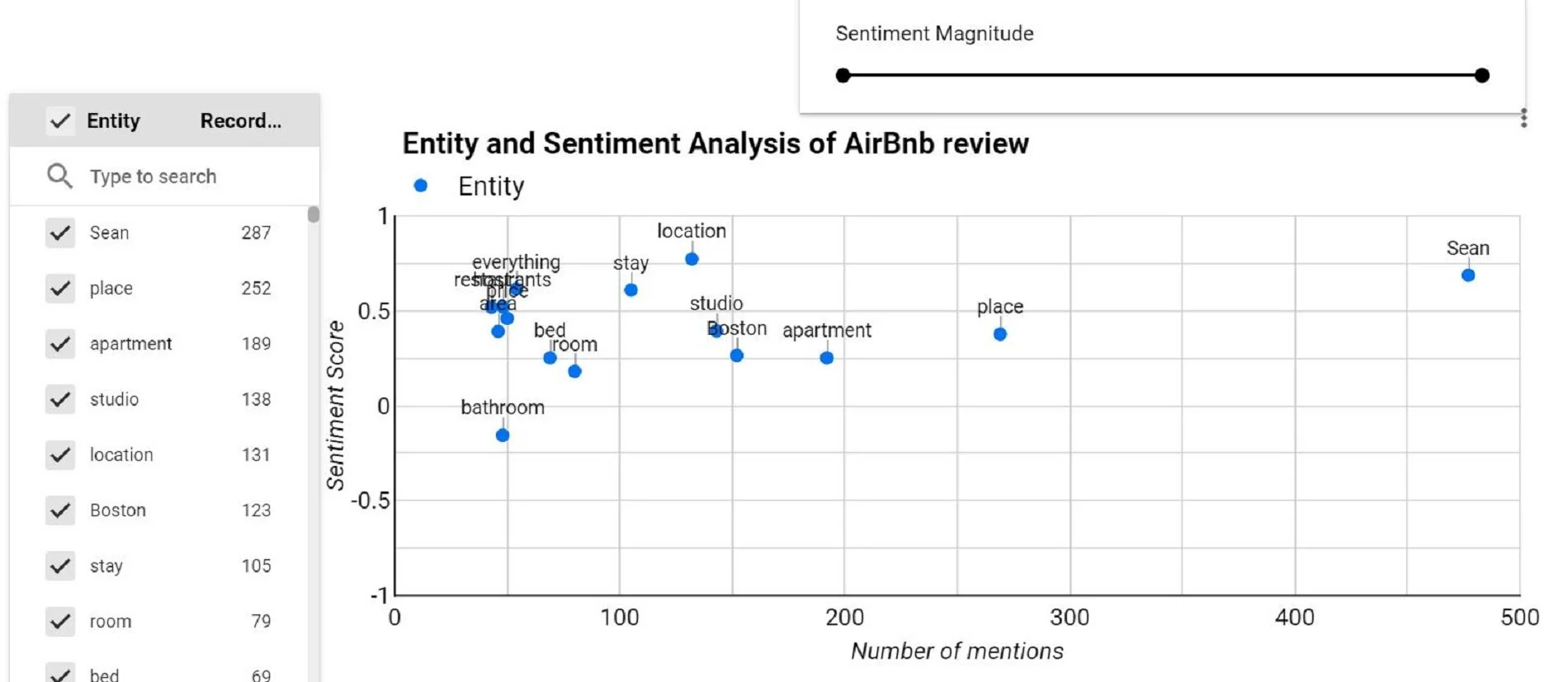How To Extract Entity Type In Natural Language API - Google Cloud Platform
In the first blog post that used Alicia William’s script on Entity/Sentiment analysis using Apps script + NL API, it covered how to associate sentiment with the entity. However, what if you wanted to extract the entity type as well? Example here:
The original post has the instructions for the full setup. There are only two changes that you need to do.
Line 45 of the code, you create a column name called ‘Entity type’
var esHeader = [['Review ID','Entity','Entity type', 'Salience','Sentiment Score','Sentiment Magnitude','Number of mentions']];
And in line 75, call the entity.type function as part of the API request.
var row = [reviewId, entity.name, entity.type, entity.salience, entity.sentiment.score, entity.sentiment.magnitude, entity.mentions.length
That’s it. If you follow the instructions mentioned in the original post + this script, you should see Entity type values getting populated. Link to first post on Entity/Sentiment analysis in Natural Language API.
/** * Performs entity sentiment analysis on english text data in a sheet using Cloud Natural Language (cloud.google.com/natural-language/). */ var COLUMN_NAME = { COMMENTS: 'comments', LANGUAGE: 'language_detected', TRANSLATION: 'comments_english', ENTITY: 'entity_sentiment', ID: 'id' }; /** * Creates a ML Tools menu in Google Spreadsheets. */ function onOpen() { SpreadsheetApp.getUi() .createMenu('ML Tools') .addItem('Mark Entities and Sentiment', 'markEntitySentiment') .addToUi(); }; /** * For each row in the reviewData sheet with a value in "comments" field, * will run the retrieveEntitySentiment function * and copy results into the entitySentiment sheet. */ function markEntitySentiment() { // set variables for reviewData sheet var ss = SpreadsheetApp.getActiveSpreadsheet(); var dataSheet = ss.getSheetByName('reviewData'); var rows = dataSheet.getDataRange(); var numRows = rows.getNumRows(); var values = rows.getValues(); var headerRow = values[0]; // checks to see if entitySentiment sheet is present; if not, creates new sheet and sets header row var entitySheet = ss.getSheetByName('entitySentiment'); if (entitySheet == null) { ss.insertSheet('entitySentiment'); var entitySheet = ss.getSheetByName('entitySentiment'); var esHeaderRange = entitySheet.getRange(1,1,1,6); var esHeader = [['Review ID','Entity','Entity type', 'Salience','Sentiment Score','Sentiment Magnitude','Number of mentions']]; esHeaderRange.setValues(esHeader); }; // find the column index for comments, language_detected, comments_english var commentsColumnIdx = headerRow.indexOf(COLUMN_NAME.COMMENTS); var languageColumnIdx = headerRow.indexOf(COLUMN_NAME.LANGUAGE); var translationColumnIdx = headerRow.indexOf(COLUMN_NAME.TRANSLATION); var entityColumnIdx = headerRow.indexOf(COLUMN_NAME.ENTITY); var idColumnIdx = headerRow.indexOf(COLUMN_NAME.ID); if (entityColumnIdx == -1) { Browser.msgBox("Error: Could not find the column named " + COLUMN_NAME.ENTITY + ". Please create an empty column with header \"entity_sentiment\" on the reviewData tab."); return; // bail }; ss.toast("Analyzing entities and sentiment..."); // Process each row for (var i = 0; i < numRows; ++i) { var value = values[i]; var commentEnCellVal = value[translationColumnIdx]; var entityCellVal = value[entityColumnIdx]; var reviewId = value[idColumnIdx]; // Call retrieveEntitySentiment function for each row that has comments and also an empty entity_sentiment cell if(commentEnCellVal && !entityCellVal) { var nlData = retrieveEntitySentiment(commentEnCellVal); // Paste each entity and sentiment score into entitySentiment sheet var newValues = [] for each (var entity in nlData.entities) { var row = [reviewId, entity.name, entity.type, entity.salience, entity.sentiment.score, entity.sentiment.magnitude, entity.mentions.length ]; newValues.push(row); } if(newValues.length) { entitySheet.getRange(entitySheet.getLastRow() + 1, 1, newValues.length, newValues[0].length).setValues(newValues); } // Paste "complete" into entity_sentiment column to denote completion of NL API call dataSheet.getRange(i+1, entityColumnIdx+1).setValue("complete"); } } }; /** * Calls the NL API with a string * @param line The line of string * @return the entities and related sentiment present in the string. */ function retrieveEntitySentiment (line) { var apiKey = "your-api-key"; var apiEndpoint = 'https://language.googleapis.com/v1/documents:analyzeEntitySentiment?key=' + apiKey; // Create our json request, w/ text, language, type & encoding var nlData = { document: { language: 'en-us', type: 'PLAIN_TEXT', content: line }, encodingType: 'UTF8' }; // Package all of the options and the data together for the call var nlOptions = { method : 'post', contentType: 'application/json', payload : JSON.stringify(nlData) }; // And make the call var response = UrlFetchApp.fetch(apiEndpoint, nlOptions); return JSON.parse(response); };




![Google Cloud Video Intelligence API - Object Tracking in Python Example [Multiple Videos]](https://images.squarespace-cdn.com/content/v1/5640e86be4b031347f7c7b81/1602880829926-6T1VH8YKFCXQ2WPBWCHO/Google+Cloud+Video+Intelligence+API+Python+sample+object.JPG)


